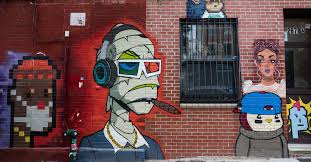
Street art, once bound to brick and concrete, is now stepping into the digital frontier—Web3. Artists who once tagged alleys and bridges are minting NFTs, turning ephemeral street pieces into collectible digital assets. It’s a radical shift from spray cans to smart contracts.
By entering the NFT space, street artists are reclaiming value for their work. Walls are public, vulnerable to weather and whitewash. But a digital mural on the blockchain is permanent, traceable, and monetizable. This empowers artists who’ve long created for free to now earn and gain recognition.
Moreover, the Web3 space allows global audiences to engage with urban art. A mural in Bengaluru can be auctioned by a collector in Berlin. Artists can also embed interactive features, AR layers, or unlockable content in their NFTs—something a physical wall could never do.
Yet, the transition isn’t just about technology—it’s about identity. Street art is rooted in rebellion and accessibility. Some worry that NFTs commercialize a form meant to be free. But many artists are using blockchain to retain independence, bypass galleries, and directly connect with fans.
From graffiti to digital galleries, the journey of street artists into Web3 signals evolution. The wall isn’t gone—it’s just gone virtual.